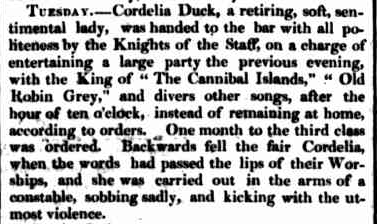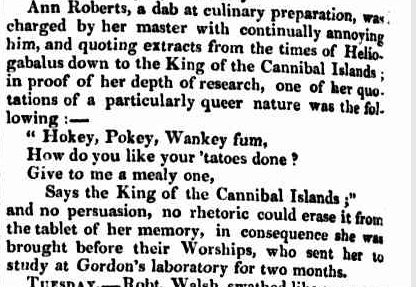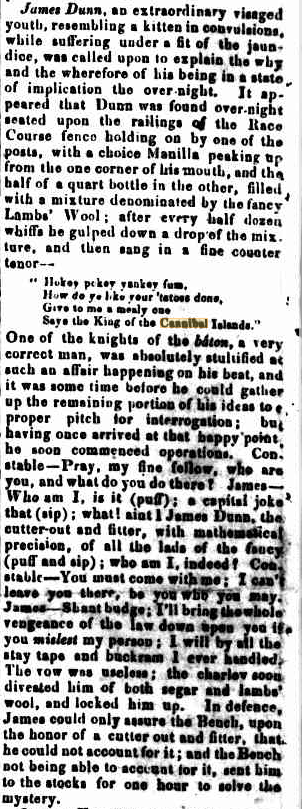From a Police Report in the Sydney Herald, 10th of June 1832
Ann Roberts, a dab at culinary preparation, was charged by her master with continually annoying him, and quoting extracts from the times of Helfogabalus down to the King of the Cannibal Islands; in proof of her depth of research, one of her quotations of a particularly queer nature was the following :
“Hokey, Pokey, Wankey fum,
How do you like your ‘tatoes done?
Give to me a mealy one,
Says the King of the Cannibal Islands;”
and no persuasion, no rhetoric could erase it from the tablet of her memory, in consequence she was brought before their Worships, who sent her to study at Gordon’s laboratory for two months.
From a Police Report in the Sydney Herald, 5th of July 1832
James Dunn, an extraordinarily visaged youth, resembling a kitten in convulsions, while suffering under a fit of jaundice, was called upon to explain the why and wherefore of his being in a state of implication the over-night. It appeared that Dunn was found over-night seated upon the railings of the Race Course fence holding on by one of the posts, with a choice Manilla peaking up from the corner of one corner of his mouth, and the half of a quart bottle in the other, filled with a mixture denominated by the fancy Lamb’s Wool; after every half dozen whiffs he gulped down a drop of the mixture and then sang in a fine counter-tenor –
“Hokey, Pokey, Wankey fum,
How do you like your ‘tatoes done?
Give to me a mealy one,
Says the King of the Cannibal Islands;”
One of the knights of the baton, a very correct man, was absolutely stupified at such an affair happening on his beat, and it was some time before he could gather up the remaining portion of his ideas to a proper pitch for interrogation; but having once arrived at that happy point, he soon commenced operations.
Constable – Pray, my fine fellow, how are you, and what do you do there?
James – Who am I, is it (puff); a capital joke that (sip); what! ain’t I James Dunn, the cutter-out and fitter, with mathematical precision, of all the lads of the fancy (puff and sip); who am I, indeed!
Constable – You must come with me; I can’t leave you here, be you who you say.
James – Shant budge; I’ll bring the whole vengeance of the law down upon you if you mislest my person; I will by all the stay tape and buckram I ever handled.
The vow was useless; the charley soon divested him of both segar and lamb’s wool, and locked him up. In defence, James could only assure the Bench, upon the honor of a cutter out and fitter, that he could not account for it; and the Bench, not being able to account for it, sent him to the stocks for one hour to solve the mystery.
From a Police Report in the Sydney Herald, 5th of July 1832
 Cordelia Duck, a retiring, soft, sentimental lady, was handed to the bar with all politeness by the Knights of the Staff, on a charge of entertaining a large party the previous evening, with the King of “The Cannibal Islands,” “Old Robin Grey,” and divers other songs, after the hour of ten o’cldck, instead of remaining at home, according to orders. One month to the third class was ordered. Backwards fell the fair Cordelia, when the words had passed the lips of their Worships, and she was carried out in the arms of a constable, sobbing sadly, and kicking with the utmost violence.
Cordelia Duck, a retiring, soft, sentimental lady, was handed to the bar with all politeness by the Knights of the Staff, on a charge of entertaining a large party the previous evening, with the King of “The Cannibal Islands,” “Old Robin Grey,” and divers other songs, after the hour of ten o’cldck, instead of remaining at home, according to orders. One month to the third class was ordered. Backwards fell the fair Cordelia, when the words had passed the lips of their Worships, and she was carried out in the arms of a constable, sobbing sadly, and kicking with the utmost violence.
Notes
Gordon’s Laboratory refers to the female factory, run by Mrs. Gordon. It was common for female convicts to be punished by being sent there, although this is an oddity as a fairly long sentence for a relatively minor offence.
The Cannibal Islands are now known as Fiji.
The song has two different versions that survive, one of which is the probable descendant of the version sung by the convicts. Curiously, despite a verse about Botany Bay at the start in this version, the song has survived poorly in Australia and is better known in the US. The words to the song may be inspired by the adventures of Captain Browning.
References
POLICE INCIDENTS. (1832, July 5). The Sydney Herald (NSW : 1831 – 1842), p. 2. Retrieved January 31, 2017, from http://nla.gov.au/nla.news-article12844819
POLICE INCIDENTS. (1833, June 10). The Sydney Herald (NSW : 1831 – 1842), p. 2 (Supplement to the Sydney Herald.). Retrieved September 28, 2017, from http://nla.gov.au/nla.news-article12846998
POLICE INCIDENTS. (1836, November 10). The Sydney Gazette and New South Wales Advertiser (NSW : 1803 – 1842), p. 2. Retrieved February 19, 2020, from http://nla.gov.au/nla.news-article2207664




